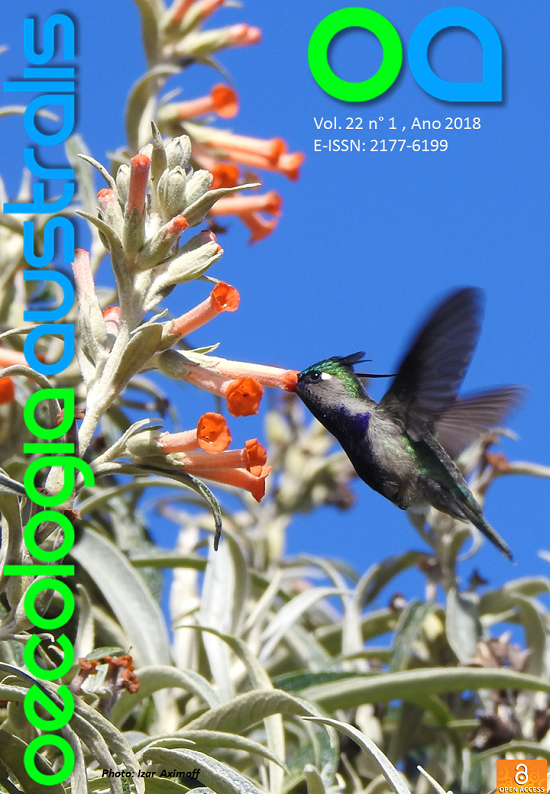EFEITO DO AMBIENTE TÉRMICO NA ATIVIDADE DIÁRIA DE Tropidurus hygomi (SQUAMATA: TROPIDURIDAE) EM RESTINGAS DO NORDESTE DO BRASIL
DOI:
https://doi.org/10.4257/oeco.2018.2201.02Keywords:
behavior, foraging behavior, temperature, thermoregulationAbstract
Lagartos alcançam um ótimo de temperatura corpórea através de mecanismos comportamentais como modificação da posição do corpo em relação ao sol ou movendo-se para sítios de termorregulação. Dentro do contexto da relação entre padrões comportamentais, temperatura corpórea e uso do microhabitat, esse trabalho teve o objetivo de descrever e analisar as atividades diárias de Tropidurus hygomi (Squamata, Tropiduridae), relacionando a influência do ambiente térmico no tempo de investimento em termorregulação de duas populações disjuntas em áreas de restinga no Nordeste do Brasil, municípios de Jandaíra, Bahia, e Pirambu, Sergipe. Os valores obtidos para as variações da temperatura do substrato (ΔTs) e do ar ( ΔTa) para as populações de T. hygomi analisadas sugerem comportamento de termorregulação ativa. As médias de valores de ΔTs foram menores que as de ΔTa o que indica a temperatura do substrato como principal fonte de calor durante a termorregulação de T. hygomi. Os comportamentos variaram pouco ao longo do dia nas duas restingas, com predomínio da termorregulação empoleirado e baixa locomoção entre as manchas de vegetação. A diferença na heterogeneidade ambiental entre as restingas, evidenciada pela maior média de altura de vegetação em Pirambu, não influenciou os padrões comportamentais e as temperaturas corporais da espécie, mostrando que este lagarto mantém um padrão térmico conservativo ao longo de sua distribuição geográfica.
THERMAL ENVIRONMENT EFFECT IN DAILY ACTIVITY OF Tropidurus hygomi (SQUAMATA: TROPIDURIDAE) IN RESTINGAS OF THE NORTHEASTERN OF BRAZIL. Lizards reach an optimal body temperature through behavioral mechanisms such as change of body position to the sun or moving from sites of thermoregulation. Within the context of the relationship between behavioral patterns, body temperature and microhabitat use, this work aimed to describe and analyze the daily activities of Tropidurus hygomi (Squamata, Tropiduridae), relating the influence of the thermal environment in the time of investment in thermoregulation of two disjunct populations in “Restinga” areas in Northeastern Brazil, municipalities of Jandaíra, state of Bahia, and Pirambu, state of Sergipe. The values obtained for the variation in substrate (ΔTs) and air (ΔTa) temperatures for the analyzed populations of T. hygomi suggest active thermoregulation behavior. The mean values of ΔTs were lower than the mean values of ΔTa, which indicates the substrate temperature as the main heat source during the thermoregulation of T. hygomi. The behaviors varied little along of the day in the two “restingas”, with a predominance of perched thermoregulation and low locomotion among vegetation patches. The difference in environmental heterogeneity between the “restingas” evidenced by the higher mean height of vegetation in Pirambu did not influenced the behavioral patterns and the body temperatures of the species, showing that this lizard maintains a conservative thermal pattern along its geographic distribution.


